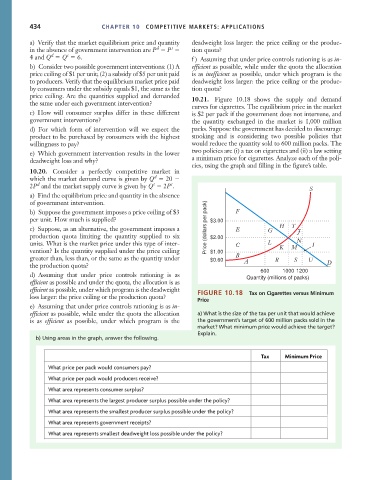Page 460 - Microeconomics, Fourth Edition
P. 460
c10competitive markets applications.qxd 7/15/10 4:58 PM Page 434
434 CHAPTER 10 COMPETITIVE MARKETS: APPLICATIONS
a) Verify that the market equilibrium price and quantity deadweight loss larger: the price ceiling or the produc-
d
s
in the absence of government intervention are P P tion quota?
d
s
4 and Q Q 6. f ) Assuming that under price controls rationing is as in-
b) Consider two possible government interventions: (1) A efficient as possible, while under the quota the allocation
price ceiling of $1 per unit; (2) a subsidy of $5 per unit paid is as inefficient as possible, under which program is the
to producers. Verify that the equilibrium market price paid deadweight loss larger: the price ceiling or the produc-
by consumers under the subsidy equals $1, the same as the tion quota?
price ceiling. Are the quantities supplied and demanded 10.21. Figure 10.18 shows the supply and demand
the same under each government intervention?
curves for cigarettes. The equilibrium price in the market
c) How will consumer surplus differ in these different is $2 per pack if the government does not intervene, and
government interventions? the quantity exchanged in the market is 1,000 million
d) For which form of intervention will we expect the packs. Suppose the government has decided to discourage
product to be purchased by consumers with the highest smoking and is considering two possible policies that
willingness to pay? would reduce the quantity sold to 600 million packs. The
e) Which government intervention results in the lower two policies are (i) a tax on cigarettes and (ii) a law setting
deadweight loss and why? a minimum price for cigarettes. Analyze each of the poli-
cies, using the graph and filling in the figure’s table.
10.20. Consider a perfectly competitive market in
d
which the market demand curve is given by Q 20
s
d
2P and the market supply curve is given by Q 2P . s
S
a) Find the equilibrium price and quantity in the absence
of government intervention.
b) Suppose the government imposes a price ceiling of $3 F
per unit. How much is supplied? $3.00
c) Suppose, as an alternative, the government imposes a Price (dollars per pack) E H T
production quota limiting the quantity supplied to six $2.00 G J
units. What is the market price under this type of inter- L N
vention? Is the quantity supplied under the price ceiling $1.00 C K M I
greater than, less than, or the same as the quantity under $0.60 B
the production quota? A R S U D
600 1000 1200
d) Assuming that under price controls rationing is as Quantity (millions of packs)
efficient as possible and under the quota, the allocation is as
efficient as possible, under which program is the deadweight FIGURE 10.18
loss larger: the price ceiling or the production quota? Tax on Cigarettes versus Minimum
Price
e) Assuming that under price controls rationing is as in-
efficient as possible, while under the quota the allocation a) What is the size of the tax per unit that would achieve
is as efficient as possible, under which program is the the government’s target of 600 million packs sold in the
market? What minimum price would achieve the target?
Explain.
b) Using areas in the graph, answer the following.
Ta x Minimum Price
What price per pack would consumers pay?
What price per pack would producers receive?
What area represents consumer surplus?
What area represents the largest producer surplus possible under the policy?
What area represents the smallest producer surplus possible under the policy?
What area represents government receipts?
What area represents smallest deadweight loss possible under the policy?

